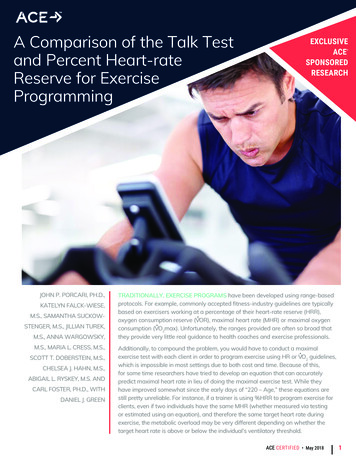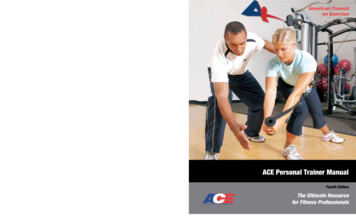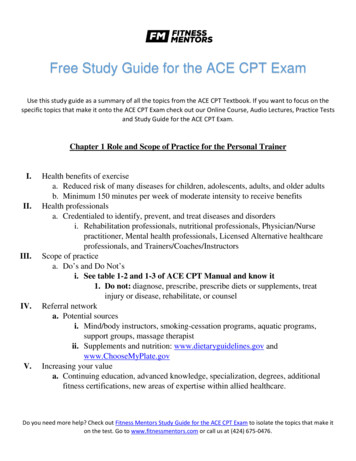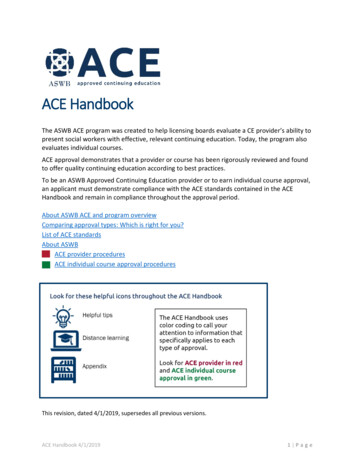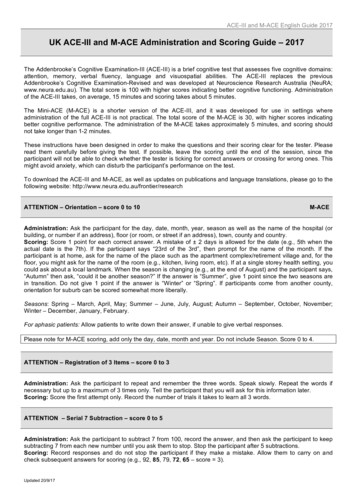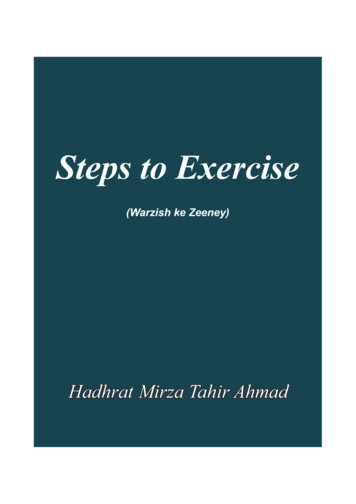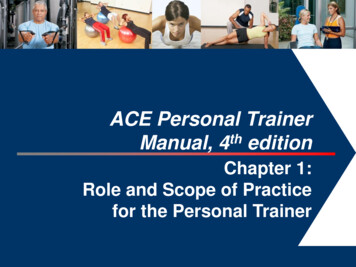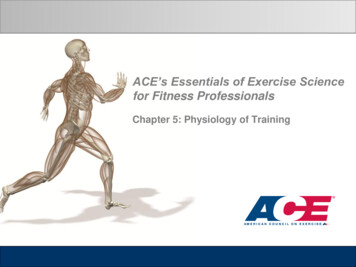
Transcription
ACE’s Essentials of Exercise Sciencefor Fitness ProfessionalsChapter 5: Physiology of Training
Learning Objectives This chapter presents the acute and chronic adaptations tocardiorespiratory, resistance, and flexibility training, as well asprinciples that should guide the design and progression of an exerciseprogram. Upon completion of this chapter, you will be able to:– List the acute and chronic adaptations of the cardiovascular and respiratory systemsin response to exercise– Explain fuel use during exercise– Describe acute adaptations of the muscular system, including muscle contractilityand fatigue– Explain muscle growth and muscle-fiber adaptations in response to a progressivetraining program– List and apply general training principles: specificity, progressive overload,diminishing returns, and reversibility– Describe the acute and chronic adaptations to flexibility training
Acute Responses to Exercise Going from rest to exercise requires the circulatory and respiratorysystems to increase oxygen delivery. To meet the increased demands of the muscles, two majoradjustments in blood flow occur:– Redistribution of blood flow from the inactive organs to the active skeletalmuscles– Increased cardiac output (Q SV x HR) Regulation of heart rate is controlled:– Intrinsically by the sinoatrial node (SA node)– Extrinsically by the nervous and endocrine systems– Changes in heart rate are influenced by the parasympathetic andsympathetic divisions of the autonomic nervous system (ANS).
Inherent Rhythm of the Heart Because of its specialized capacity, cardiac muscle is able tomaintain its own rhythm. The inherent rhythm of the heart is about 100 bpm and occursbecause it can be innately stimulated via spontaneousdepolarization and repolarization of the SA node.– Impulses that originateat the SA node spreadto the atrioventricular node(AV node), causing theatria to contract together,then the ventricles tocontract together.
Parasympathetic Regulation Parasympathetic fibers reach the heart via the vagusnerves, which will make contact at both the SA node andAV node. When stimulated, vagus nerve endings releaseacetylcholine, decreasing SA and AV node activity andreducing heart rate.
Sympathetic Regulation Sympathetic fibers connect to the heart via the cardiacaccelerator nerves, which innervate the SA node andventricles. When stimulated, epinephrine and norepinephrine arereleased, accelerating depolarization of the SA node andincreasing heart rate and contractility. At the onset of exercise, the initial increase in heart rate(up to 100 bpm) is due to the withdrawal ofparasympathetic tone.
Sympathetic Regulation (cont.) Increased cardiac output is influenced by:– An increase in end diastolic volume, which causes a stretch in cardiacfibers, thereby creating a stronger force of contraction– Stronger contractility results in more blood pumped per beat (i.e., agreater stroke volume) Increased blood flow to the working muscles is a result of:– Vasoconstriction of the vessels supplying non-working muscles (exceptthe heart) and vasodilation of the vessels supplying the workingmuscles– Autoregulation, which is the monitoring system of the effectiveness ofblood flow in response to the accumulation of metabolites– Vasoconstriction of the arteries supplying the viscera, which shifts bloodfrom the abdominal organs to the working muscles
Blood Pressure During Exercise Systolic blood pressure has amuch higher increase duringexercise than diastolic bloodpressure due to:– Increased contractility of the heart– Increased stroke volume– The muscular need for greater forceand pressure to deliver blood to theexercising muscles– Vasodilation within the exercisingmuscle, which results in more blooddraining from the arteries, through thearterioles, and into muscle capillaries
Blood Distribution During Exercise Exercise affects the blood flow to various organ systems differently.– For example, skeletal muscle receives about 15–20% of total cardiac outputduring rest, but 80–85% during maximal exercise. Blood volume is affected by the hydrostatic pressure of a musclecontraction, accumulation of metabolites, and sweat. The body preserves blood volume during exercise by several means:– Offsetting the small decrease in stroke volume by increasing heart rate (duringsteady state exercise)– Increasing vasoconstriction in non-working muscles to maintain peripheralresistance and blood pressure– Releasing vasopressin and aldosterone to help reduce water and sodium loss During resistance training, the working muscles experience a temporaryincrease in fluid accumulation, which results in a feeling of fullness in themuscle (transient hypertrophy).
Ventilatory Regulation Aerobic exercise results in:– An increase of oxygen to the working tissues– Increased return of carbon dioxide to the lungs– An increase in the volume of air breathed per minute (minuteventilation—VE) During submaximal exercise, ventilation increasesproportionately with increased oxygen consumption andcarbon dioxide production. As intensity increases to near maximal, the minuteventilation increases disproportionately to oxygenconsumption.
Ventilatory Response to Exercise Ventilatory response to exerciseincreases linearly, with theexception of two distinctdeflection points at the first andsecond ventilatory thresholds(VT1 and VT2).– VT1 represents the increasedrespiratory response to removeextra CO2 produced by the bufferingof lactate as it begins to accumulatein the blood.– VT2 represents the blood bufferingsystems becoming overwhelmed byrapidly increasing blood lactate.
Fast-acting Hormones Hormones that ensure blood glucose maintenance during exercise andquickly return blood glucose concentrations back to normal afterexercise include the catecholamines (epinephrine and norepinephrine).– Increase cardiac contractility, leading to increased cardiac output– Vasoconstriction of non-working muscles increases total peripheralresistance, causing an increase is systolic blood pressure (SBP) Epinephrine only:– Dilates respiratory passages and reduces digestive activity and bladderemptying– Stimulates the mobilization of stored carbohydrates and fats, the productionand release of glycogen, and glycogenolysis in skeletal muscle– Promotes lipolysis– Alerts the central nervous system (CNS) of impending stressors
Insulin and Glucagon Activation of the sympathetic system during exercisesuppresses the release of insulin from the pancreas.– Insulin sensitivity increases, requiring less insulin for the sameeffect.– Glucose uptake by the skeletal muscle occurs at a higher rate. Glucagon, also released from the pancreas, stimulatesan almost immediate release of glucose from the liver.– Facilitates an increase in blood glucose levels in response to lowlevels (negative feedback loop)– This reaction takes effect as exercise progresses and glycogenstores deplete.
Slow-acting Hormones Cortisol, released by the adrenal cortex, stimulates themobilization of free fatty acids (FFA) from adipose tissue,mobilizes glucose synthesis in the liver, and decreasesthe rate of glucose utilization in the cells.– Increases with intensity and stress on the body– Prolonged elevated levels have been linked to excessive proteinbreakdown, tissue wasting, negative nitrogen balance, andabdominal obesity. Growth hormone, released by the anterior pituitarygland, supports the action of cortisol and plays a role inprotein synthesis.– Dramatic increase during short-term physical activity
Fuel Use During Exercise: Carbohydrates Carbohydrates are the major macronutrientfor the metabolic production of adenosinetriphosphate (ATP).– Stored as glycogen in the muscle and liver– Glycogenolysis is the primary regulator ofblood glucose. Carbohydrates used during exercise comefrom both glycogen stores in muscle tissueand blood glucose.– The relative contribution of muscle glycogenand blood glucose used during exercise isdetermined by intensity and duration.– After the first hour of submaximal exercise,carbohydrate metabolism shifts from muscleglycogen to glycogenolysis in the liver.
Fuel Use During Exercise: Fats Fats are mainly stored as triglycerides in adipocytes,which must be broken down into FFAs and glycerol.– During low-intensity exercise, circulatingFFAs from adipocytes are the primaryenergy source from fat, but duringhigher intensities, muscle triglyceridemetabolism increases.– As duration increases, the role ofplasma FFAs as a fuel source increases.
Fuel Use During Exercise: Protein Protein plays a small role in thefueling of exercise.– It must be broken down into aminoacids, which can be supplied to themuscle tissue from the blood andfrom the muscle fiber itself. Skeletal muscle can directlymetabolize certain amino acids toproduce ATP. During exercise, glucose storedin a non-exercising muscle can bedelivered indirectly to the exercisingmuscle via the glucose-alaninepathway.
Energy System Contributions During Exercise
Lactate as Fuel Lactate is generally thought of as a wasteproduct of glycolysis. Plays a role in glucose production in theliver (gluconeogenesis)– During exercise, some of the lactic acidproduced by skeletal muscle istransported to the liver via the blood andconverted back to glucose.– It is released into the bloodstream, andtravels back to the skeletal muscles to beused as an energy source.– The cycle of lactate to glucosebetween the muscle and theliver is called the Cori cycle.– Serves as a direct fuel sourcefor skeletal muscle and the heart
Muscle Contractility Muscle contractility depends on maximal force production, speed ofcontraction, and muscle fiber efficiency. Fast-twitch muscle fibers– Contain more myosin cross-bridges per cross-sectional area of fiber andproduce 10–20% more force than slow-twitch muscle fibers– Have a higher concentration of myosin ATPase, allowing them tocontract at a higher speed Slow-twitch muscle fibers– Are more efficient at using oxygento generate ATP to fuel continuousmuscle contractions due to theirhigher concentrations of myoglobin,larger number of capillaries, andhigher mitochondrial enzymeactivity.
Muscle Fatigue Muscle fatigue is associated with an acute bout of prolongedexercise in which muscular performance declines and sensations ofmuscle pain occur.– When muscle glycogen is depleted, an increasein the use of fat for energy occurs.– Fat mobilization and oxidation are muchslower, resulting in a reduction of poweroutput of the muscle.– Drinking a glucose and water solution near thepoint of fatigue may help for a short time, butglycogen will remain depleted.– High-carbohydrate diets ( 60% of caloriesfrom carbohydrates) and carbohydrate loadingcan extend performance before “hitting the wall.”
Thermoregulation During Exercise in Altered Conditions In the heat:– Thermal core receptors signal the hypothalamus that core temperatureis rising, which directs the nervous system to commence sweating andincrease blood flow to the skin.– While four mechanisms are used to give off heat, evaporation is themajor contributor during exercise.
Exercise in the Cold Three primary ways in which the body avoids excessive heat loss:– Peripheral vasoconstriction– Nonshivering thermogenesis– Shivering Air and water are the two major cold stressors.– As windchill increases, so does therisk of freezing body tissue.– The body loses heat four to five timesfaster in water than in air of the sametemperature.
Chronic Adaptations to Exercise Regular, consistent exercise leads to several adaptations that allowthe body to improve performance. Cardiorespiratory changes– Cardiorespiratory endurance capacity is determined by the ability of thecardiovascular and respiratory systems to deliver oxygen to activetissues, and the ability of those tissues to extract and use the oxygenduring prolonged bouts of exercise.
Cardiorespiratory Changes: Blood Volume Increase in blood volume– An initial, rapid adaptation to exercise– Increase is due primarily to plasma and, to a lesser extent, redblood cells– Plasma volume can increase 12 to 20% after three to sixaerobic-training workouts.– The number of red blood cells may increase, but the ratio of redblood cell volume to total blood volume may decrease.
Cardiorespiratory Changes: Heart Size and Volume Heart size and volume– Increase as an adaptation to increased work demand,but return to pre-training levels within several weeks iftraining ceases– Characterized by an increase of the left ventricularcavity and slight thickening of the walls– Increase in size is due to endurance training and anincrease in blood volume– These adaptations lead to an increase in cardiac forceand the amount of blood pumped per beat.– Decreased resting heart rate (RHR) and exercise heartrate for a given intensity allow for longer diastolic fillingand a reduced work requirement for the heart.– Improved maximal oxygen uptake (VO2max) anddecreased cardiac stress
Fick Equation Used to determine the rate at which oxygen is beingused during physical activity– VO2 Q x a-vO2 difference Q Cardiac output (HR x SV) oxygen delivery a-vO2 difference oxygen extraction
Fick Equation Components Improvements in VO2max are due to increases in one ormore of the following variables:–Stroke volume Increases at rest and during exercise result from regular training–Heart rate Regular training typically yields:– Decreased RHR of more than 10 bpm– Decreased submaximal heart rate of 10–20 bpm–a-vO2 difference Increases with training, particularly at maximal exercise Reflective of greater oxygen extraction at the tissue level and moreeffective distribution of blood flood to active tissue
Cardiorespiratory Changes: Blood Flow and Pressure Blood flow– Increased blood flow to working muscles is enhanced throughregular endurance training due to: Increased capillarization of trained muscles Greater recruitment of existing capillaries in trained muscles More effective blood flow redistribution from inactive areas to activetissues Increased blood volume Blood pressure– In response to regular endurance training, a decrease in restingSBP and DBP is noted only for borderline or moderatelyhypertensive individuals.– Resistance training may also reduce SBP.
Cardiorespiratory Changes: Oxidative Enzymes Oxidative enzymes– Responses to regular endurance training include: Increase in the size and number of mitochondria in skeletal muscle– Enhances the muscle’s ability to use oxygen and produce ATP viaoxidation Increase in the activity of the mitochondrial oxidative enzymes– Slower rate of muscle glycogen utilization– Enhanced reliance on fat as fuel at any given exercise intensity
Neural Changes More significant as a resultof resistance training thanaerobic training– Occur in the early part of astrength-training program(1–3 weeks) before musclehypertrophy occurs Motor-unit recruitment andsynchronization– All-or-none principle: Whenactivated, all muscle fibers in amotor unit contract maximally.
Neural Changes (cont.) Rate coding– A motor unit produces varying levels of force depending on thefrequency at which it is stimulated. Twitch Summation Tetanus– May increase with resistance training Diminished co-contraction– In opposing muscles, whenmaximizing force generatedby the agonist, theactivation of the antagonistmust be diminished.
Hormonal Changes Generally, the hormonal response to a given exercise load declineswith regular endurance training. Resistance-training adaptations result in increases in growthhormone and testosterone (especially in men), which are associatedwith strength improvement.
General Adaptation Syndrome General adaptation syndrome refers to the body’s predictableresponse to stressful events (including heavy exercise). Three stages– Shock or alarm phase (usually lasts 2 to 3 weeks) The individual initially exhibits signs of fatigue, weakness, and soreness. He or she soon experiences remarkable gains (attributed to neuromuscularadaptations).– Adaptation or resistance phase (begins around weeks 4 to 6) Major muscular adaptations (biochemical, mechanical, and structural) Progressive increases in muscle size and strength– Exhaustion phase (may occur at any time) Symptoms similar to the first phase, but inadequate repair or recovery timelead to burnout, overtraining, reduction or elimination of overload, injury,illness, or lack of adherence
Overtraining Overtraining often occurs during periods of intense overload in which signsand symptoms are individualized and include a combination of bothphysiological and emotional factors. Some signs and symptoms include:– A decline in physical performance with continued training– Elevated heart rate and blood lactate levels at a fixed submaximal work rate– Weight loss– Sleep disturbance– Multiple colds or sore throats– Irritability, restlessness, excitability,and/or anxiousness– Loss of motivation and vigor– Lack of mental concentration and focus– Lack of appreciation for things that are normally enjoyable The best way to prevent overtraining is periodization.
Delayed Onset Muscle Soreness (DOMS) Research suggests DOMS is caused by tissue injury from excessivemechanical force, particularly eccentric force, exerted on muscle andconnective tissue. Generally appears 24–48 hours after strenuous exercise Is thought to result from a series of events activated by strenuous exercise:– First, structural damage occurs as a result of strenuous eccentric muscle actions.– As a result, calcium is leaked out of the sarcoplasmic reticulum and collects in themitochondria, halting ATP production.– The build-up of calcium activates enzymes that break down proteins.– The breakdown of proteins causes an inflammatory process.– Lastly, the accumulation of histamines, potassium, prostaglandins, and edemastimulates pain receptors, leading to the sensation of DOMS. Attempt to reduce DOMS by starting at a low intensity and progressing slowlythrough the first few weeks while minimizing eccentric actions.
General Training Principles Principle of specificity– The exercise response to any training program is specific to themode and intensity of training. Principles of overload and progression– Overload involves increasing the load on the tissue or systemabove and beyond the normal load.– Progression is the systematic process of applying overload.
General Training Principles (cont.) Principle of diminishing returns– The rate of fitness improvementdiminishes over time as anindividual’s fitness approaches itsultimate genetic potential. Principle of reversibility– When training ceases, all gains willreturn to pre-training levels and maypossibly decrease to the point wherethey are only supporting thedemands of daily use.
Muscle Growth After a prolonged period of resistance training, chronic hypertrophy isresponsible for strength gains. Fiber hypertrophy– Results from one or more of the following: increased number of myofibrils,increased number of actin and myosin filaments, more sarcoplasm, and moreconnective tissue– Increased protein synthesis– Eccentric actions combined with high-velocity training promote greater increases. Fiber hyperplasia– Stress to the muscle stimulates the migration of satellite cells to the damagedregion to fuel existing muscle fibers and/or produce new ones.– In humans, most evidence points to muscle-fiber hypertrophy as the primarycause of increased muscle size associated with resistance training.
Enhancing Muscle Growth Through Exercise A resistance-training program that stimulates proteinsynthesis (and muscle growth) increases levels oftestosterone and growth hormone.– Growth hormone increases the availability of amino acids forprotein synthesis and stimulates the release of IGF-1, whichworks with GH to stimulate muscle growth.– Testosterone promotes the release of GH and interacts withneuromuscular system to stimulate muscle growth.– These responses are brought about by performing large-musclegroup, multijoint exercises at high intensities with short restintervals (30 to 60 seconds).
Muscle Glycogen Storage Approximately 300–400 grams of glycogen is stored in skeletalmuscles and approximately 70 to 100 grams is stored in the liver.- At intensities 60% VO2max, muscle glycogen is the predominant fuelsource. Liver glycogen is more important during low-intensity activity.- Enhancing muscle glycogen storage involves eating a carbohydrate-richdiet and consuming carbohydrates within 30 minutes of high-intensityexercise.- It takes about 24 hours to fully restore muscle glycogen, if nutrientneeds are met post-workout and the athlete was properly fueled prior tothe workout.
Muscle-buffering Capacity Muscle-buffering capacity refers to the muscles’ ability to neutralize thelactic acid that accumulates in them during high-intensity activity.– Delays the onset of fatigue– Allows the exerciser to perform at a higher intensity and duration before“hitting the wall” Training at the lactate threshold will enhance buffering capacity and delaymuscle fatigue for subsequent training sessions. Ventilatory threshold is an indirect representation of lactate threshold.– Endurance training improves the ability to sustain high levels of submaximalventilation.
Heat Acclimation Adaptations can take place as early as 9 to 14 days. Adaptations include:– Increased plasma volume– Decreased heart rate and core temperature– Increased sweat rate
Tissue Properties Affecting Flexibility Training Tissue elasticity– Mechanical property that allows a tissue to return to its originalshape or size when an applied force is removed (“temporarydeformation”)– A tissue reaches its “elastic limit” when it is stretched beyond thepoint where it cannot return to its normal length when tensile(stretching) force is removed.– The difference between the original resting length and newresting length is called “permanent deformation.”– The new state of permanent elongation is called “plastic stretch.”– Static stretching elongates the tissue to a point wheredeformation remains after the tension is removed.
Flexibility Training (cont.) Tissue plasticity– Allows the tissue to deform when it is loaded past its elastic limit– Once a tissue is set past its yield point, tissue failure resulting inadditional deformation may occur with small increases in force. Tissue viscoelasticity– Viscosity allows tissues to resist loads and is dependent on timeand temperature.– With exposure to low loads, most tissues exhibit elastic behavior;exposure to higher loads causes tissue to exhibit a plasticresponse
Neurological Properties of Stretching Autogenic inhibition: the activation of a Golgi tendon organ (GTO)inhibits muscle spindle response– Initially, a low-force, long-duration (static) stretch stimulates low-grademuscle spindle activity and temporary increases in muscle tension.– Muscle spindles become desensitized as the stretch continues (referredto as stress-relaxation).– After 7 to 10 seconds, the increase in muscle tension activates the GTOresponse, inhibiting muscle spindle activity and allowing further musclestretching.– Holding the stretch beyond 10 seconds stresses the collagen fibers,causing plastic deformation and lengthening the tissue (creep).– When the stretch ends, muscle spindles reestablish their threshold.– Repeating the stretch a finite number of times produces a gradualincrease in muscle extensibility.
Neurological Properties of Stretching (cont.) Reciprocal inhibition– Activating the muscle on one side of a joint (i.e., the agonist)coincides with neural inhibition of the opposing muscle on theother side of the joint (i.e., the antagonist) to facilitate movement.– Example While performing a supine hamstring stretch, contraction of the hipflexor muscles on the leg being stretched will produce more activehip flexion, resulting in reciprocal inhibition of the hamstring musclegroup, allowing them to be stretched further.
Static Stretching Static stretching involves moving the joints to placethe targeted muscle group in an end-range positionand holding that position for up to 30 seconds.–Does not elicit the stretch reflex, reducing the risk ofinjury with proper technique–Active–Passive
Proprioceptive Neuromuscular Facilitation (PNF) PNF incorporates the principles of autogenic inhibition andreciprocal inhibition. There are three types of PNF, all of which begin with a passive(partner) 10-second pre-stretch.– Hold-relax– Contract-relax– Hold-relax with agonist contraction
Dynamic and Ballistic Stretching Dynamic stretching– Mimics the movement pattern to be used in an upcomingworkout.– Dynamic stretching is an effective component of a warm-up. Ballistic stretching– Incorporates bouncing-type movements– Typically triggers the stretch-reflex, which increases the risk ofinjury– Has a role in conditioning and training if done correctly
Active Isolated Stretching (AIS) AIS follows a design similar to a traditional strengthtraining program.– Stretches, which never last longer than 2 seconds, areperformed in sets, with each movement exceeding theresistance point of the prior stretch by a few degrees.– Each set isolates an individual muscle.
Myofascial Release Myofascial release applies pressure to tight, restricted areas of fascia andunderlying muscle in an attempt to relieve tension and improve flexibility–It is thought that sustained pressure to a tight area can inhibit tension in amuscle by stimulating the GTO to bring about autogenic inhibition.–Trigger points can be diminished through the application of pressure followed bystatic stretching of the tight area.In the fitness setting, a foam roller is used, allowing the exerciser to controlhis or her own intensity and duration of pressure.
Static Stretching and Permanent Tissue Elongation Static stretching– Low-force, long-duration stretching at elevated tissuetemperatures is more likely to result in plastic lengthening(compared to high-force, short duration).– Dynamic stretching can be used to warm up the muscles, and befollowed by static stretching.– Static stretching is most effective when performed during thecool-down at the end of a training session.– Holding the stretch for 15 to 30 seconds appears to be the mosteffective means of increasing range of motion.– Each stretch should be repeated up to three to four times.
Summary Understanding the transition from rest to exercise and the adaptations that occurin response to regular training is essential for proper exercise selection andprogram design. This chapter covered:– Acute responses to exercise– Fast- and slow-acting hormones– Fuel use during exercise– The three energy systems– Thermoregulation during exercise– Chronic adaptations to exercise– Cardiorespiratory, neural, and hormonal changes– General training principles– Muscle growth– Flexibility training
ACE’s Essentials of Exercise Science for Fitness Professionals Chapter 5: Physiology of Training . Learning Objectives This chapter presents the acute and chronic adaptations to cardioresp


